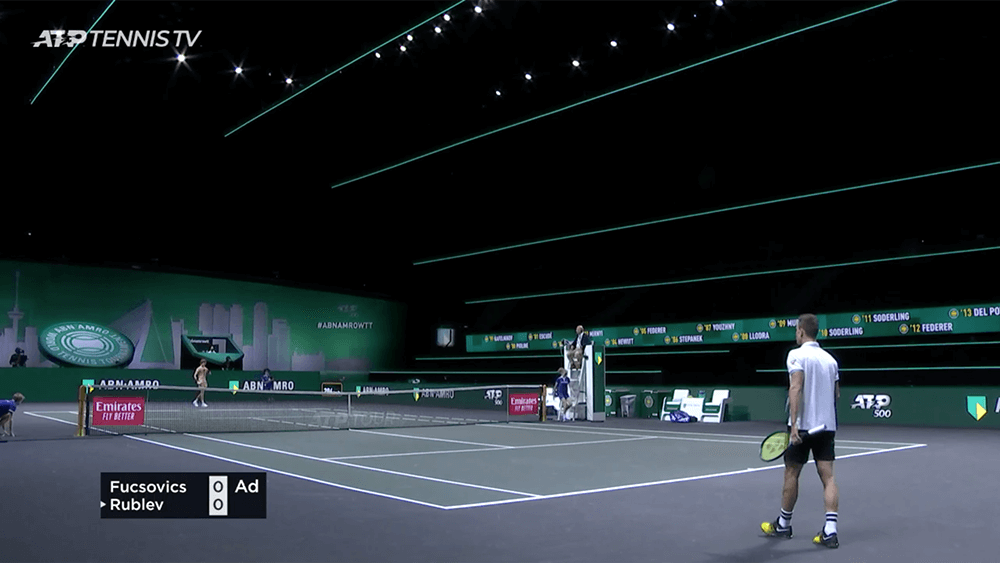
Organizers of the ABN AMRO World Tennis Tournament at Rotterdam Ahoy made changes to enhance the experience of fans watching on TV.
Last fall, after months of in-person events were converted to online-only, event producer Heather Mason said in a Convene interview that her fellow strategists need to start reimagining digital events as broadcasts.
“Where we go wrong is we are trying to put on an event online. And I think that immediate thinking has got to go out the window,” said Mason, CEO of Caspian Agency. “What the new thinking and new approach should be is, ‘I want to engage my audience. Who is my audience? I am now a broadcaster … using a screen as my medium.’”

Nine screens showing fan messages helped the players feel like fans were present.
While Mason cited Hollywood, TikTok, Netflix, and YouTube as entities broadcasting with their audiences in mind, sporting events also have altered their strategies to enhance how the audience at home experiences games. Organizers of the recent ABN AMRO World Tennis Tournament in the Netherlands, played March 1-7 at the Rotterdam Ahoy, knew exactly who their audience was when giving the professional tournament a makeover.
Like many sporting events over the past year, fans were not allowed on site for the annual Rotterdam tournament because of COVID-19 restrictions. “We have a TV product only,” tournament director Richard Krajicek told atptour.com, adding that organizers wanted to make the viewing experience “as nice as possible” for those fans.
The first order of business was to make both players and fans feel like they were connecting with each other despite not being together. To achieve this, organizers did what live TV shows, like “The Voice” in Australia, have done during the pandemic. They placed nine TV screens close to new player entrances that showed video messages posted by fans on social media to their favorite players.

Organizers of the tournament used backdrops, banners, and special lighting to create a more intimate atmosphere and put focus on the tennis.
Taking Focus Away From Empty Seats
The biggest change at Rotterdam Ahoy, a convention center and multi-purpose arena that hosted an innovative drive-through art exhibit in 2020, was hiding more than 16,000 seats that normally would be filled by fans.
Tournament organizers and Rotterdam Ahoy used large backdrops around the two tennis courts, which meant both players and viewing fans weren’t distracted by the empty stands. One backdrop showed a silhouette view of Rotterdam’s skyline, while on the other court banners depicting past champions were hung with the backdrop.
Another tweak involved new show lighting at the venue. During play, bright lights illuminated the court area. When the players took their changeover breaks, the lights were dimmed on the court, making the white lines of the court stand out for fans watching on TV. The effect created a more intimate atmosphere for viewers — of which I was one — and focused our eyes on the tennis action and nothing else.
The tournament’s tweaks set the broadcast apart from other televised tournaments. Similarly, during a studio broadcast or when live streaming a small in-person event, hybrid event organizers can consider transforming a view of empty seats through the use of screens and colorful backdrops and paying attention to how lighting can help signal changes in the program in order to improve the online audience’s experience.
As Mason said in her Convene interview and during her PlanetIMEX Community Day webinar, “A New Approach to Digital Engagement,” when you think of your online event as a broadcast, it will open your mind to other ways of doing things to make it more “vibrant and interesting and watchable.”
Curt Wagner is digital editor at Convene.
